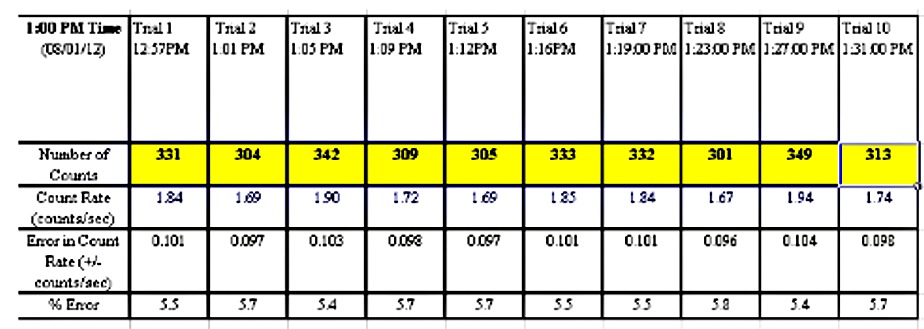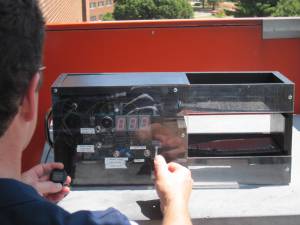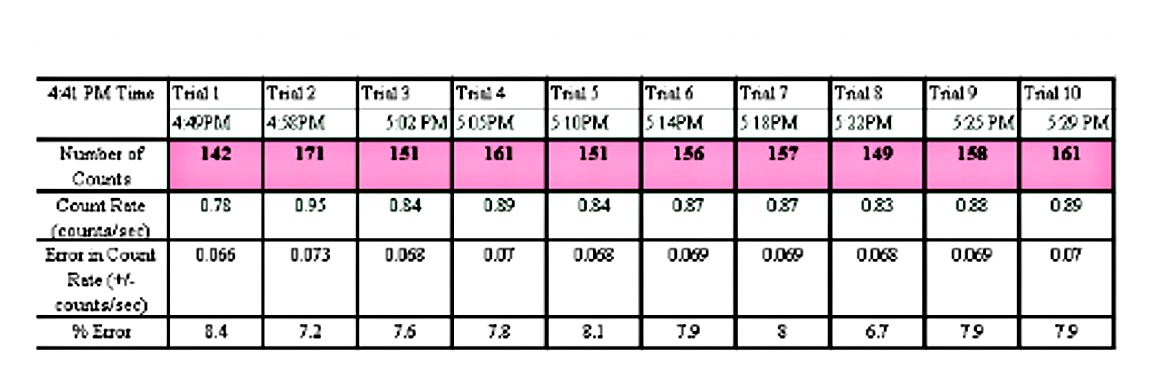Table of Contents
The Experiment and Data
We selected three time periods: 9 PM, 5 AM, and 1 PM. The idea was to take data from solar noon (1:00 PM EDT is 12:00 noon EST), a time that was dark (5:00AM) and a time that was in the twilight 9:00PM. As it was these three time periods also neatly divided the day into three equal 8 hour periods as well. The intent was to take ten 3-minute test trials for each of the time periods.
Since we had access to the detector, we decided to take some additional data to test the instrument and the technique. At 4:00, we proceeded to the test area to set up our experiment. We immediately found a problem with our scintillator since one of the scintillating panels was not functioning. After a phone call to our helpful concierge(Dr. Constan), we obtained a different instrument. The instrument was tested briefly in Dr. Constan's office, and we returned to the location of the experiment.
More Troubles… After setting up the new instrument, we began taking data. To our chagrin, we found that the new instrument was not functioning properly either. Like the other instrument, one of the scintillating panels did not seem to be working. Since we were already after hours, it was decided to take data with one scintillating panel. Here's the data that was obtained.
Weather conditions… Partly cloudy, little wind.
The numbers seemed close to the numbers that we collected when running the test trial in the lab room. However, we were concerned with the fact that we were not taking coincidence readings. The plan was to talk to Dr.'s Constan or Kilburn at dinner…. well…
Needless to say, we didn't see either of them at dinner. So, let's experiment. 9:00 PM Data We decided to proceed as we did at 4:00 PM, taking data from just the one functioning panel. Here's the data that we took.
Weather conditions: Clear, sun close to setting, little wind.
It should be noted that after the 2nd trial, the scintillator began taking data at a much higher rate. Either we were being exposed to much greater radiation levels or, the thought was, the detector began to work properly. We continued to take data through the 10 trials. Then, thinking that the detector was properly functioning, we took coincidence data as well. We took 4 trials before the detector began acting erratically again. We called it a night.
5:00 AM Data
We set up the instrument and tried to take coincidence data immediately. It seeming worked well for the ten three-minute trials we took.

Weather conditions: Dark. Calm sky.
As before, the yellow represents data taken in the coincidence mode, while the pink is data from only one panel. You can observe that something happened between trials 11 and 12.
You can understand our lack of confidence in the readings that we took.
1:00 PM Data
As planned, detector willing, we hoped to take some more data at 1:00 PM. Here is what we recorded.
Weather conditions: Partly cloudy, midday sun, little wind.




